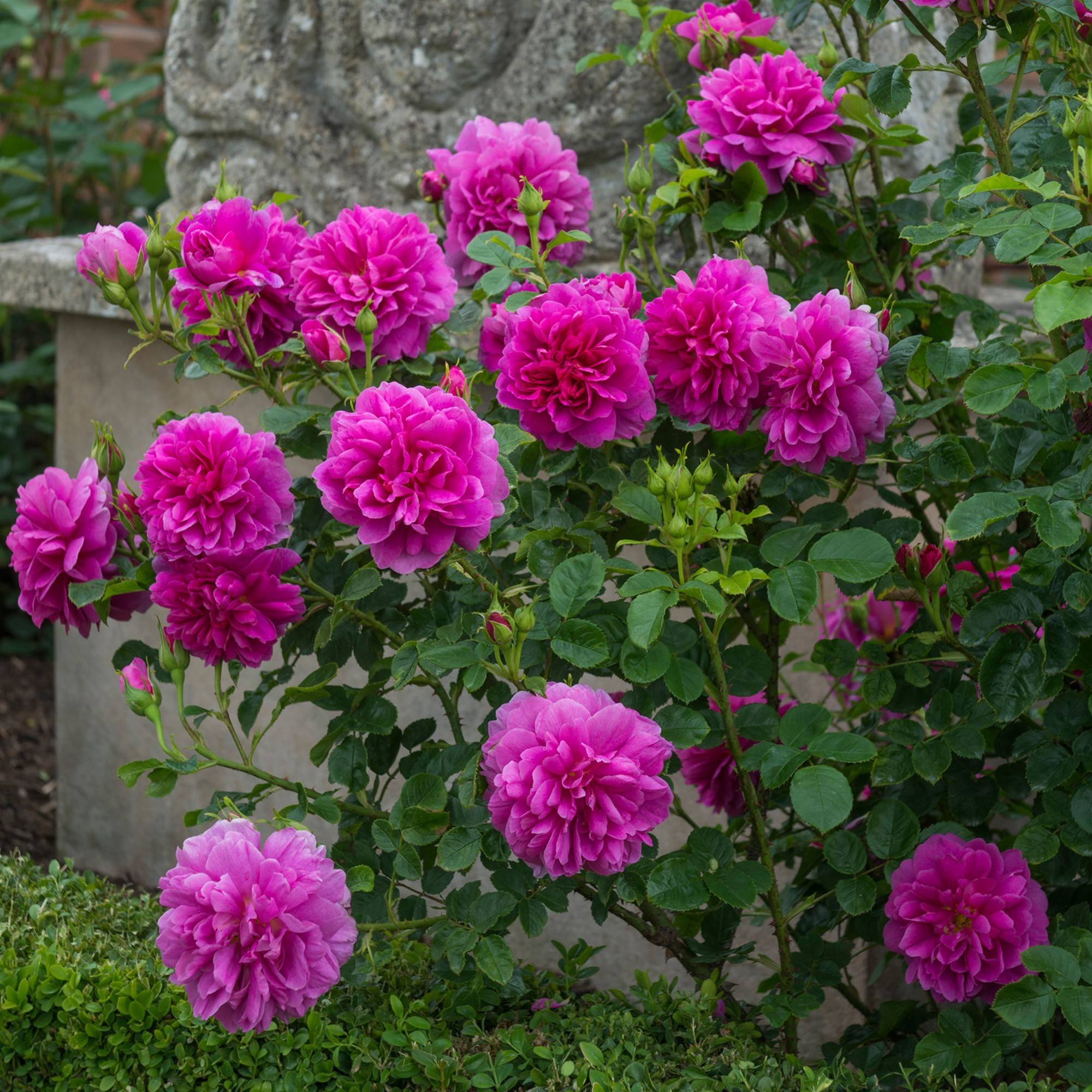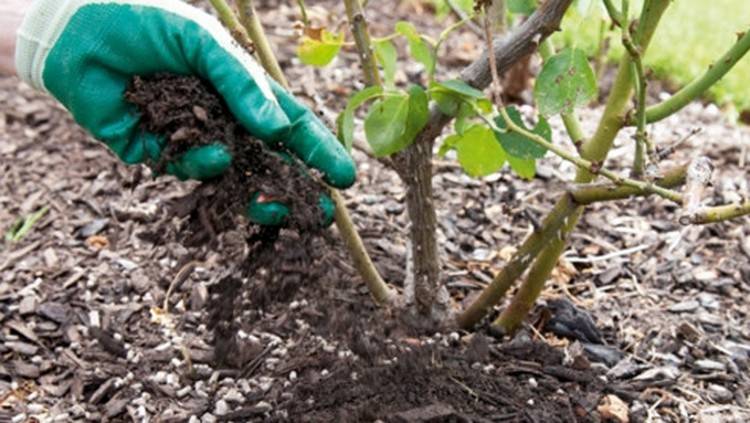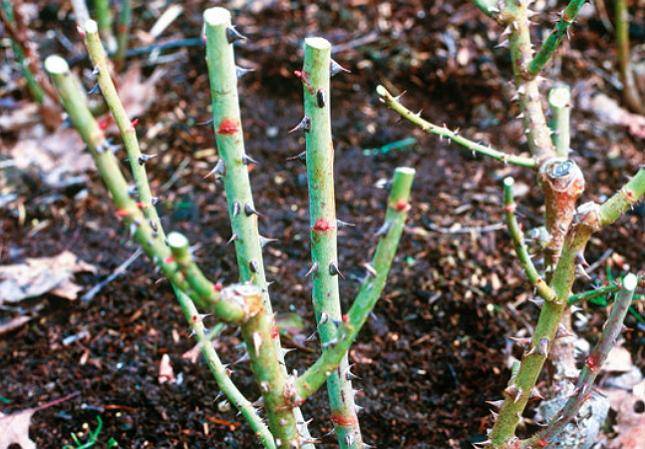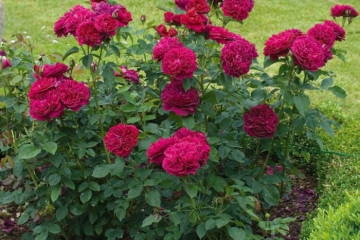Rose Princess Anne (Princess Anne) - variety description
Content:
Rose Princess Anna belongs to the group of scrubs, which includes new hybrids that do not belong to such large species as floribunda, grandiflora or hybrid tea.
Rose Princess Anna (Princess Anne) - what is this variety
The rose was bred by the famous English breeder D. Austin in 2010. The variety was named in honor of the daughter of Queen Elizabeth II - Princess Anne.
Brief description and characteristics
An upright bush of the Princess Anna variety grows up to a meter in height. Thanks to its numerous shoots, its width reaches 90 cm. The stems are densely covered with thorns. Leaves are leathery shiny.
The flowers differ in shape from other hybrids: densely stuffed with narrow petals, the number of which reaches 80-85 pieces. During flowering, they change their palette. Only a blossoming raspberry bud over time acquires a pink color with a lilac tint. On the underside, the petals are light yellow, which gives the rose the impression of a light glow. The diameter of the flower itself is 8 cm. The flowers are collected in a brush.
Advantages and disadvantages of the variety
Rose Princess Anna is an unpretentious plant, but when buying, you should weigh the pros and cons of the variety and make sure that there are no problems with growing.
The advantages of the variety:
- flowering throughout the season;
- high resistance to disease;
- medium resistance to rain;
- cold resistance in climatic zones 6-9;
- stands for a long time in the cut for a bouquet.
Disadvantages of the variety:
- on sandy soil, the flower quickly crumbles;
- short-lived bloom in direct sunlight.
Use in landscape design
English bush roses look good in group plantings in combination with other ornamental crops, and in single plantings, and in a classic rose garden.
The compact shape of the Princess Anne bush is suitable for hedges, curbs. Park roses can beautify any style of landscape.
Growing a flower: how to plant it in open ground
The future life of the beauty depends on the correctly chosen place for planting a rose and following the procedure for planting it in the ground.
To grow roses in your garden, choose one of the following methods:
- seeds;
- cuttings;
- vaccination;
- purchase of ready-made seedlings.
The most unproductive and unpredictable method is seed reproduction. The resulting plants will differ from the parental shrubs without retaining the properties of the variety.
Cutting completely retains the varietal characteristics of the bush, but requires scrupulous adherence to all the rules.
A sure way to get a plant is to get healthy grafted seedlings.
What time is the boarding
The best time to plant a seedling in the ground is mid-spring, when the ground is fully warmed up. Planting in autumn is permissible if weather conditions do not prevent the plant from taking root.
Seat selection
For a rose, choose a place where the bush will receive enough sunlight in the morning and evening hours, and be in light shade at noon.
The site should not be located in a low area where cold air collects.
Princess Anne is a rose whose roots penetrate deep into the ground, so they select a site with a low groundwater level, at least a meter.
How to prepare the soil and flower for planting
All roses prefer fertile light soil with a slightly acidic reaction, pH 5.8-6.5. A soil unsuitable for a rose can be refined:
- add sand, humus or peat to heavy loamy soil;
- add clay to the sandy soil, mixing it with compost, sod soil;
- to increase the acidity of the soil, peat is introduced;
- to reduce acidity, the soil is limed, ash is added.
The purchased seedlings should also be prepared for planting. After purchase, they are stored in a cool place, and before planting, they are soaked for several hours in water.
Planting procedure step by step
They plant a rose Princess Anna immediately to a permanent place, because the variety can hardly be transplanted.
- Prepare a landing pit with a depth of 70 cm.
- Drainage (gravel, crushed stone) is laid at the bottom with a layer of 10 cm.
- Compost mixed with soil from the pit is brought in.
- Pour the earth into the hole in the form of a cone.
- The roots of the seedling are first placed in a clay mash, then gently straightened along an earthen cone.
- The hole is filled up so that the root collar after compaction is 3 cm below the soil level.
- After watering, the soil around the bush is mulched.
Plant care
In order for the beautiful Princess Anna to thank her with a healthy look and abundant flowering, you need to take into account some of the features of caring for her.
Watering rules and humidity
Park roses do not need frequent watering, it is enough to water them once a week when the top layer of the earth dries up. Watering is carried out in the morning or in the evening with always settled water.
On hot days, the frequency of watering can be increased to maintain the required humidity. This is especially true on sandy loam soil to prevent the petals from shedding.
At the end of summer, watering is less frequent and watering is completely stopped in September.
Top dressing and soil quality
Top dressing of the rose bush is carried out seasonally. In the spring, the plant needs fertilizers containing nitrogen. This top dressing will accelerate the formation of new shoots, help the rapid growth of the bush.
Before flowering, the rose is fed with potassium-phosphorus fertilizer, which will give it energy both for lush flowering and for preparation for winter.
The rose planting site is kept clean, removing weeds. Shallow loosening is periodically carried out. To facilitate maintenance, the soil under the bush is mulched.
Pruning and replanting
In the spring, pruning begins when the buds are swollen. Frozen, damaged branches are cut. Healthy shoots are shortened by a third. It is the middle pruning that is required for all rose bushes with erect shoots, which include the Princess Anna variety.
In the summer, during weak pruning, faded plants are removed.
In the fall, sanitary pruning is carried out: the overgrown bush is thinned out, damaged shoots are cut off.
The Princess Anna variety is grafted onto a stock, which does not give wild animals, and its roots go deep down, so the bush does not tolerate transplanting well. As a last resort, you can transplant by transshipment plants no older than 5 years.
Features of wintering a flower
The variety has good winter hardiness, but in the conditions of the Middle Lane it needs shelter. They begin to cover after the arrival of stable cold weather.
The roots are covered with earth, compost. Moisture-intensive sawdust, peat for hilling are not suitable, as they can provoke an infection. Spruce branches are laid on top and covered with non-woven material.
Blooming rose
The flowering bush of the rose Princess Anna is easy to distinguish from other varieties from afar: it contains crimson and pink flowers at the same time.
A period of activity and rest
The variety begins to bloom in June and stops after frost. Repeated flowering: one to two weeks pass between the first wave and the second.
Care during and after flowering
Before flowering, the bush is fed with potassium-phosphorus fertilizer. Faded inflorescences are removed so as not to weaken the flowering of the rose. Weeds are regularly removed around the bush.
What to do if it does not bloom
If Princess Anne refuses to bloom, it is worth analyzing the description of possible reasons:
- wrong landing site;
- unsuitable soil;
- high or low deepening of the root collar;
- insufficient insulation for wintering;
- miscalculations when fertilizing, watering, pruning bushes.
The adjustments made will be able to make the rose bloom next year.
Flower propagation
The most convenient and productive method for propagating roses for an inexperienced grower is cuttings.
Cuttings are cut in the summer after the first or second wave of flowering.
Above the shoot bud, a cut is made at an angle of 45 °. For several hours, a stalk of 2-3 internodes is kept in a root growth stimulator.
After a month, roots will appear on the handle.
Diseases, pests and ways to control them
Rose Princess Anne is resistant to diseases, and pests bypass her. Only susceptibility to gray and root rot is noticed. If gray rot can be detected visually by small spots on the stems and gray bloom on the buds, then root rot is manifested by the wilting of the plant when it is too late to save it.
Rose Princess Anna will decorate any garden even with minimal effort, and if you follow the rules of care, it will generously thank you with long flowering.




















